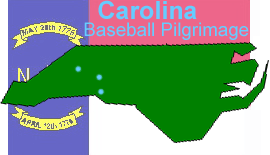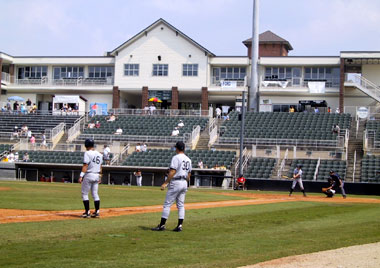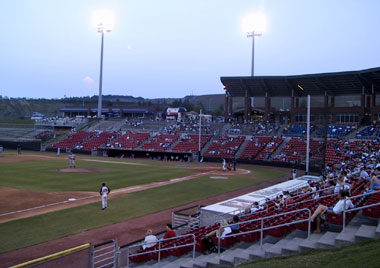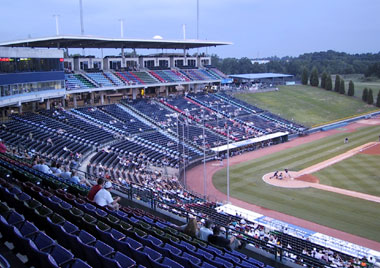The great thing about spring training is that there are many teams located within a short drive of each other and you can see many stadiums with a short commute. Although most of the games are in the afternoon, there are just enough at night to make it possible to take in a day-night doubleheader between different teams at different ballparks.

Fast forward to summer, after the majority of Major League teams have left Florida and Arizona behind, and the best place for a baseball pilgrimage is North Carolina, where 11 minor league teams are spread over five leagues, and ten of those teams are located within a 275-mile radius. Plus, minor league prices reflect savings over the discounted, but increasing, MLB prices in March.
With that in mind, I headed northeast from my Peachtree City, Georgia hub and made a North Carolina baseball excursion, catching three games in two days. After very brief planning, I opted for a pair of South Atlantic League (Class A) games on Sunday, July 21 in the towns of Kannapolis and Hickory and finished the trip by seeing the Charlotte Knights the next evening.
Packing enough items to barely fill my small gym duffel bag, I left Sunday morning in my car, a ’97 Mazda Miata synonymous with the road trip. My first stop was a 2:05 afternoon game in the mid-summer heat of Kannapolis, a city 25 miles north of Charlotte and the hometown of NASCAR legend Dale Earnhardt.
Earnhardt left his lasting imprint on the local Class A baseball team, known as the Piedmont Boll Weevils from their 1995 inception, when he and NASCAR buddies Larry Hedrick and Bruton Smith purchased the team in November of 2000. Their first act of business was to rename the team the Intimidators, Earnhardt’s long-held nickname, and design a consumer-friendly logo, which resulted in the team having the best selling hat in all of minor league baseball.
Fieldcrest Cannon Stadium
 |
Unfortunately, Earnhardt was killed at the Daytona 500 in February 2001 and never got to see the team that bore his nickname play a game. As a tribute, Kannapolis retired his number 3 on May 15, 2002, the 3 etched on a black flag in left field next to the American and North Carolina flags.
The Intimidators play in Fieldcrest Cannon Stadium, which is named for a textile company that went belly-up in 2000. Built in time for the team’s inaugural season of 1995, “The Cannon” holds 4,700 and is nestled in a secluded patch of real estate just one mile off of Interstate 85.
After paying $1 to park, I noted the stadium’s unique house-like main entrance. Fieldcrest Cannon is eerily similar to Greenville, South Carolina’s Municipal Stadium, which is my least favorite ballpark of all I have visited. The first thing you notice once inside is the lack of a roof, awning, or anything to protect fans from the sun, which was probably a contributing factor to the afternoon’s sparse attendance, generously announced at 709, but probably around 200.
The ballpark appears to be a mixture of old and new: wide concourses and comfortable seats, but an eyesore of a press box that literally looks like a trailer. The Cannon’s dominant feature is the house that runs the length of the first base line. Serving as skyboxes on the second level and concession stands and the team store on ground level, the “house” lacks the brick edifice from the exterior that made it so appetizing upon my arrival. Instead, it features the same plain white aluminum siding as the press box, although its existence is the ballpark’s signature that sets it apart from other minor league stadiums. Even though it seems tacky, the house actually serves a nice backdrop if sitting on the third-base side, which I’d recommend to take advantage of its presence. Otherwise, trees, sky, and empty seats frame the action.
Since Kannapolis is in the heart of NASCAR country, the Winston Cup standings are displayed on the main concourse where everyone can see them. The day’s lineups and league standings are tougher to locate, but exist just inside the main entrance gate. The team shop is very large and has a wide display of merchandise, thanks in part to the success of the new name and logo. They still sell the large, full color tickets from the Dale Earnhardt number retirement ceremony for $5.
Without many fans to mingle with, I struck up a conversation with Intimidators merchandise director Sean Feeney, who informed me that the rigors of minor league life extend to players and staff alike. During the weeklong homestand, I was told that Kannapolis employees log 112-hour work weeks, arriving at the ballpark by 8 am.
Kannapolis was victorious in the game, beating the Greensboro Bats 5-2. Although I wasn’t particularly pleased with the architectural features of Fieldcrest Cannon Stadium, I still enjoyed the ballgame, although the absence of shade means night games should be given a higher priority to those planning a visit.
With the afternoon game over, I hopped in my car at 5:15 for the nightcap 80 miles to the northeast in Hickory, where the Crawdads hosted the Lakewood BlueClaws at 6:05.
Hickory turned out to be the quintessential minor league ballpark experience and then some, although it took me a bit longer to get there than planned. I made a wrong turn leaving Kannapolis that cost me 15 minutes and I didn’t arrive at Hickory’s L.P. Frans Stadium until 6:45.
First off, I commend Hickory on being the one team in North Carolina that plays all of its Sunday games in the evening. The reasons are twofold: first, it provided the opportunity for the day-night double dip; second, the weather is much more pleasant at that time of day. Having left the sweltering heat behind in Kannapolis as I meandered from Interstate 85 to 77 and then 40, the weather in Hickory was a cool respite from the Hell’s Kitchen experience in the afternoon.
As I pulled into the nearly full parking lot, the game had already entered the third inning, and I showed up late enough to avoid the $1 parking fee.
L.P. Frans Stadium
 |
Located three miles from I-40 in Winkler Park, L.P. Frans Stadium (capacity 5,062) was built on donated land in 1993 and named after the local Pepsi-Cola bottler who partially funded the stadium’s construction.
After parking in the rising tiered lot, I walked downhill toward the picturesque brick ballpark that has already hosted two league All-Star games, where tickets are priced at the reasonable minor league standard of $5-7.
By the time I entered, I was very hungry and I wound up in The Crawdad Café, a sports-bar like restaurant behind first base with outdoor patio seating reminiscent of the big leagues, albeit with “normal” prices. Eight tables were set up on two levels, although the first level was reserved and the second level had some hand-railings that partly obstructed my view. For $5.50 I had a large plate of nachos with all the trimmings, which at a big league park would’ve been half the size, high in price and not as sumptuous.
Although the outdoor Café was unique, it was the people I met there that provided me with my lasting impression of Hickory.
The folks were as friendly as you’d expect from a small Southern town, but the hospitality extended to me as I ate and watched the game exceeded all reasonable expectations.
After the table next to me found out that I was from out of town, they arranged for the Crawdad’s general manager, David Haas, to come over and greet me. David brought over a complimentary team program with him and explained the in-and-outs of his duties with the team. I found out that the Pirates, the Crawdads’ affiliate, pay for player salaries and medical expenses, but Hickory is responsible for the majority of the rest, such as uniforms, travel expenses and player accommodations for road games, and paying the umpires’ salaries.
When he found out that I was going to Charlotte for Monday night’s game he took down my name and told me I’d have a free ticket waiting at the will call. His reasoning was that since I had traveled so far, I should at least have a free ticket. As it turned out, the same people own the Crawdads and Charlotte Knights.
As for the rest of the ballpark, I found it cozy, colorful, and accommodating: it had wide aisles, red and blue seats, billboard ads four stories high in right field, and a merry-go-round in the third-base concourse. It was, however, the dominating presence of brick that made L.P. Frans Stadium a true jewel in the Carolina foothills.
After watching Hickory defeat Lakewood before a solid crowd of 2,775, the players signed autograph after autograph. But this is friendly Hickory, where after the game fans are allowed to walk along the dirt path that led to the home dugout, making it even easier to obtain signatures and pictures. This just further underscored the “friendly confines” theme that marked my visit, where fans could go to the players instead of waiting for them to come to over.
Following the game I left the small towns behind and drove to the big city of Charlotte, which was an upgrade to the highest level of minor league baseball, although my ballpark visit there turned out to be highly consistent with the phrase “bush leagues.”
Dubbed the Queen City (it was named in 1765 after Queen Charlotte, the wife of King George III of Britain), Charlotte isn’t actually the home for the AAA Knights, and the team doesn’t even play in North Carolina. The city isn’t far from the South Carolina state line, and that’s what I passed over en route to Fort Mill, 15 miles south of downtown, and Knights Stadium, which opened in 1990.
The relatively non-descript ballpark is located directly off of Interstate 77 and sits adjacent to the now useless Charlotte Hornets practice facility. The first thing you notice is the towering height of the light towers and the ample parking, which is free.
I showed up just prior to when the gate opened and, as arranged by the Hickory GM, I had a ticket waiting for me at the will call: a $9 box seat located behind the home team dugout.
Knights Stadium became the 26th minor league park I had visited since the beginning of 2001, but it was the first one I’ve been to that had an upper deck, which was the home of the $5 general admission seats. For some odd reason, the team uses different colors to mark the end seats on each row in the lower deck, and the upper deck’s seats are painted an unattractive rainbow of pastel colors.
Knights Stadium
 |
The ballpark feels much older than its 12 years and more spacious due to its lack of surroundings, which consist of a forest that runs to within 50 feet of the outfield walls. The seating bowl doesn’t extend very far past either dugout, and the remaining vast expanse consists of a grassy berm that is only used for overflow crowds on Fireworks nights.
The stadium also has a merry-go-round and putt-putt golf course, which went relatively unused on my night of attendance. Among other amenities were a bar and restaurant atop the press box, and Subway and Wendy’s are a part of the concession fare. Perhaps the nicest gesture by the team is the stacks of complimentary programs, Joust, that await fans just inside the main gate.
When I first walked into the stadium, I headed for the bathroom and found it odd that the lights were not yet turned on. Since I was an early arrival I figured that the team was trying to save money by waiting until closer to game time to turn them on. As I read my program in my seat, I didn’t pay much attention to the lack of music, announcements, or even players on the field. But as the 7:15 game time approached it became increasingly apparent that the team wasn’t trying to be cheap; a power outage had occurred around 5:30 had threatened the viability of the game between the Knights and Pawtucket Red Sox.
As 7:00 neared players remained in their warm-ups and a few Pawtucket players were tossing a football near the visitors dugout. Suddenly at 6:59 power was restored and the game would go on, with a new starting time of 7:30.
Unfortunately for the home fans, of which there were few, the Knights were getting pummeled by the time the eighth inning rolled around, when things turned interesting.
With Pawtucket leading 5-1, the Knights brought in Brooks Kieschnick, a former Cub, who doubles as a DH and relief pitcher, excelling in both rolls. In fact, Kieschnick had yet to surrender a run, earned or not, over 17 innings in 12 appearances with Charlotte until the Red Sox lit him up for four runs in two-thirds of an inning. But as Kieschnick was walking back to the dugout after getting the hook the power suddenly went out again, with the exception of one bank of lights in left field.
So I found myself sitting in the suburban South Carolina wilderness in near darkness waiting out another power delay in a 9-1 blowout while the PA system played Bruce Springsteen’s “Dancing in the Dark,” and other relevant tunes. I found it amusing that the “Stadium Lights Are Always On” is the official motto for the team’s website.
Figuring that they were going to call the game, the few remaining fans headed for the exits, until an announcement was made that anyone staying until the game’s conclusion would receive a free pass to any future Knights game. The attendance was generously announced at 2,918, but it was the sparsest gathering of its size that I had ever witnessed. Not that no-shows at the 10,002-seat stadium are uncommon. Although the Knights led all of AA baseball in attendance in 1991 and 1992 when they were in the Southern League, attendance has dwindled since the Knights became a AAA franchise when the International League expanded in 1993.
With the exception of the IL’s one Canadian team in Ottawa, the Knights have the worst attendance in the league, even though home attendance was up more than 50 percent when slugger Jose Canseco played for the team in May. He decided to officially retire after hitting only .172 with 5 home runs and 9 RBIs in 18 games. His performance wasn’t enough to return him to the big leagues, and fans began to disappear after he left. Ironically, Canseco’s biggest complaint while a Knight was that the lighting made him unable to see the spin of the ball.
Charlotte had discussed building a new downtown ballpark, but talks stalled after the city turned its efforts to luring an NBA team back to town after the Hornets bolted for New Orleans, and a new downtown basketball arena to replace the 14-year “old” Charlotte Coliseum is more likely.
After 17 minutes power was back, the game resumed, and Pawtucket continued its onslaught with a pair of solo homers in the ninth inning in an 11-2 whipping of the Knights. With a pass for a free ticket in hand, I left the ballpark and concluded my brief Carolina tour, which concluded the minor league baseball experience at its best, and worst.
North Carolina Road Trip Mileage Chart
| |
Asheville |
Burlington |
Charlotte |
Greensboro |
Hickory |
Kannapolis |
Kinston |
Winston-Salem |
Zebulon |
Asheville
Burlington
Charlotte
Greensboro
Hickory
Kannapolis
Kinston
Winston-Salem
Zebulon |
196
140
174
83
155
326
146
271 |
196
128
24
125
88
134
54
79 |
140
128
108
72
43
258
95
203 |
174
24
108
102
68
154
32
100 |
83
125
72
102
84
255
75
200 |
155
88
43
68
84
218
56
164 |
326
134
258
154
255
218
184
88 |
146
54
95
32
75
56
184
130 |
271
79
203
100
200
164
88
130
|
distance calculated by mapquest.com
|
